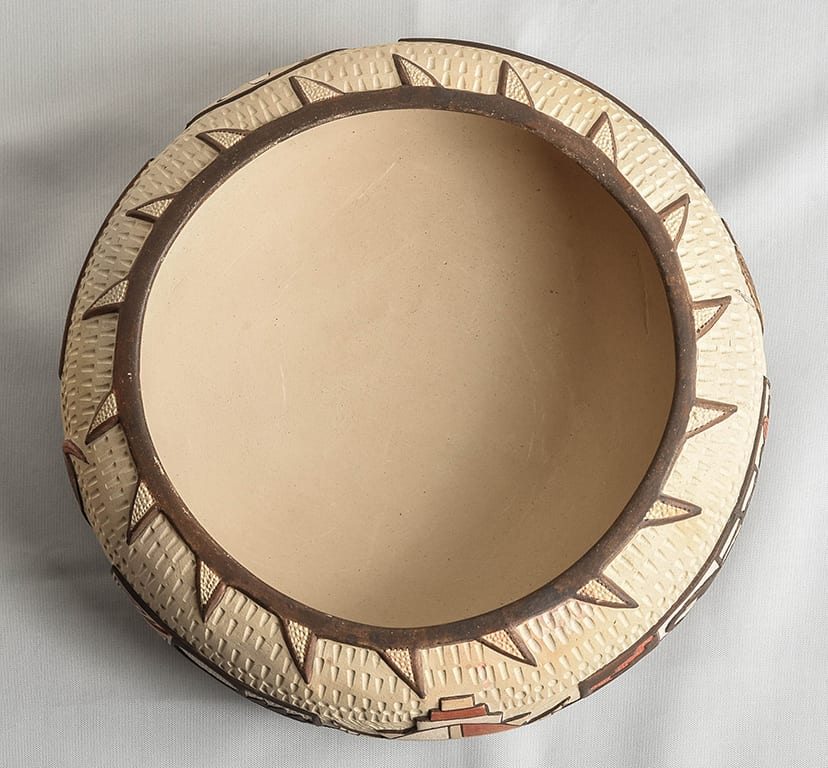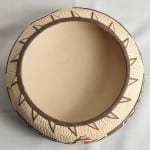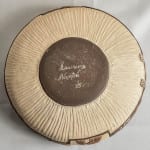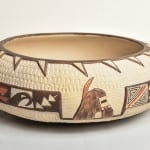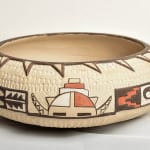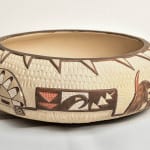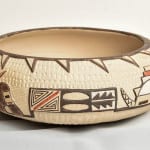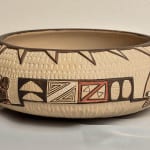I am not particularly attracted to Hopi pottery that is carved, a type apparently originating in the 1970s with the work of Tom Polacca. Indeed the two examples of his work in this collection(2005-09 and 2009-18) are early works before he began carving his pots. The only other incised pot in the collection is by Loren Hamilton Nampeyo (2011-23) and that pot is mostly painted. The quality of the carving on bowl 2015-05, however, is so compelling that I am glad to add it to this collection.
The exterior of bowl 2015-05 was intricately carved by Lawrence Namoki early in his career and foreshadows his more recent work, which is both painted and carved. Although bowl 2015-05 is aesthetically completely different than 2012-02 by Nampeyo, both are snapshots of young talent exploring options in great detail with almost perfect control. Both potters would retain design and technique from this earlier work but later make pots that were less detailed, easier to produce, and thus more suited to the demands of a commercial market.
For a carved pot, the walls of bowl 2015-05 are thinner than expected, so even that they may have been formed on a wheel, though there is no direct evidence for this supposition. The sides rise off a disk-shaped base and are divided into three bands that encircle the vessel:
1) the lower third curves outward to the bowl’s maximum diameter, 2) then the walls rise almost vertically with 3) the upper third curving inward to form the mouth of the vessel. A thin rim encircles the mouth, though the rim was not added but is the result of carving away the clay below it.
Perhaps this bowl was dried in a low temperature oven or well-protected in a cool outdoor fire, but both the interior and exterior clay are of uniform grey color with no evidence of ever having been fired. Thirty years after its production, the clay smells raw.
The bowl is signed “Lawrence Namoki” in careful, fancy script with an “’85” signifying the year of production, about two years after he began making pottery. Earlier he had learned the craft of katsina carving, so the high quality of carving on bowl 2015-05 reflects many years of experience.
I don’t know how Lawrence fashions his cottonwood katchinas, but bowl 2015-05 is very precisely carved and (more supposition) might have been formed using the same Dremel tool used to carve wood. There is a controlled sculptural quality to this work.
On the lower third of the vessel, between the disk-shaped base and the middle band of design, Lawrence has carved about 125 parallel groves. These are not perfectly-placed but vary a bit, which energizes my eye. The overall effect is a well-formed sunburst, though the bowl needs to be turned over for this pattern to be seen.
The middle band of design emerged as the surrounding clay was carved away. Four kachinas are placed at equal intervals around this band. Between them are four rectangular bands of design. Two panels contain four design elements, the remaining two panels are formed of three elements. The low areas between the spirit figures and the design panels are etched with lines that are either parallel to the rim of the jar or slanted at 45-degrees to the rim with similar patterns of etching on each side of each spirit being.
The four spirit beings/katchinas are:
#1: The central being on bowl 2015-05 represents Tawa, the spirit of the Sun and is a deity rather than a katchina (Colton, 1959, number 146). His face is a yucca basket mask, here truncated below the eyes and a red and yellow forehead. His face is surrounded by eagle feathers. To his right is a panel of three symbols, the first consists of two red isosceles triangles and the last image consisting of three such triangles pained white and mounted on a stick. Triangular images are understood to represent women and thus fecundity and growth (Patterdon, 1994:64. 253). These forms are carried as dance wands when the katchina return to Hopi and would be very familiar to Lawrence, who participates. The middle “horn” image may represent part of the headgear of the Kwa-kwanty or warrior society (Patterson, 1994:54, 237).
#2: To the right of Tawa is the depiction of Angakchina or the Long-haired kachina). Long black hair hangs down his back; a macaw feather is tied vertically at the back of his head. Bangs cover his forehead. Below is a half mask with rectangular eyes. A band of colored squares cover his chin, from which hangs a black beard. Angakchina (Colton, 1959, number 127) is a frequent dancer in Hopi villages and is associated with gentle rain. To his right is a panel of three images, the left most containing a set of triangular spirals that may represent Ho-bo-bo, the Great Whirlwind or Breath God (Patterson, 1994: 27-29, 250-252.) The middle icon is a pair of rounded half-dome, which might simply be decorative or represent a split-cloud image (Patterson, 1994:43, 141. The right-most image is a second depiction of the female dance wand.
#3: To the right of Angakchina in the design panel is a third katchina which probably represents the Mosairu or Buffalo Kachina (Colton, 1959, number 93). A two-horned katchina, lightening marks his horns and the green face mask suggest it is appearing on First Mesa, Namoki’s home. He is thought to increase the population of Buffalo and to have healing powers. To the right of Mosairu Is a four-element panel of designs. The left most is a stepped design representing rain clouds (Patterson, 1994: 58, 102, 142) and is a symbol dating from pre-historic times (see 1994-15). Next is another horn image perhaps representing Kwa-kwanty. To its right is an element consisting of two columns of three rectangles, which I have never seen before. To its right is a graceful corm plant, the substance of the Hopi people.
#4: Finally, to right of Mosairu is Ang-chin Mana or White Corn Maiden (Colton, 1959, number 128). She has a white half mask with rectangular eyes, a colored band above her beard and long black hair partially arranged in maiden’s whorls. She appears with Angakchina and supports the bringing of rain. Notice that while all the other elements of this band of design are carved, the Ang-chin Mana features a very delicately painted feather rising from her forehead. To her right is a four-element panel of design. The left most design consists of two white triangles or hills, I’m not sure. If triangles, they may again represent women and growth. To their right is the familiar set of triangular spirals that may represent Ho-bo-bo, the Great Whirlwind or Breath God. Next is a red bisected square containing triangles embedded in larger triangles. The design is unique on this jar, but as with the triangular motifs already discussed, may be interpreted as representing women and fecundity. Finally we see two mature corncobs, again representing the central source of sustenance for the Hopi people.
Notice that Angakchina (#2) and Ang-chin Mana (#4) are oriented so that each faces Mosairu, the Buffalo Katchina #3). These three katchina form a set, leaving the deity Tawa visually isolated.
Above the band of design containing the katchinas is the uppermost design band. Most of this band consists of three rows of short vertical engraved triangles pointed toward the bottom of the bowl. Below them is a row of engraved dots. Below them another row of engraved triangles, this time pointing up. The carved katchina images from the middle band of design intrude up into the third row of engraved triangles. Attached to the rim and pointing down are 18 relatively large isosceles triangles with black edges. These intrude down into the top two rows of engraved triangles. When bowl 2015-05 is viewed directly from above, these triangles grow out of the painted round rim and form the image of the sun.
Over-analytical art historians often read meaning into art that the artist did not consciously place there. I am struck, however, by my sense that the bottom groves on this bowl remind me of a sunburst and the top view of the bowl seems like a very different image of the same radiant sun.
Meanwhile the carved image that stands alone in the middle panel of design is Tawa, the Sun God.
It may all be Pahana speculation, but the unifying theme of bowl 2015-05 seems to be a homage to the Sun, our Creator.
The carving of this bowl is very complicated, and a reader patient enough to read this detailed description of the designs on bowl 2015-05 will readily agree that the images are intricate and precise. The bowl is a thoughtful tour de force of design based on a thorough knowledge of Hopi spiritual life and must have taken hours of planning and execution. Later work by Lawrence is just a thoughtful and precise, but has simpler designs. Bowls this complicated could not be produced fast enough to provide a reasonable income.
“Lawrence (born 1949) grew up in Walpi, the Hopi village on First Mesa. He now lives in Polacca, the village just below First Mesa. He served in Vietnam as a Green Beret, then came home and worked as a Kachina carver. In 1985, began to make pottery, as well as Kachinas. Lawrence is an active member of his clan, and maintains that only an active member knows the true Hopi signs that he incorporates into his work. A one of a kind potter, Lawrence specializes in colors that no other Hopi potter uses. His vegetal and mineral paints are all derived from his experimenting with different herbs and minerals native to the Hopi Reservation. Reds are from iron oxide clays he finds near the Grand Canyon. Greenish-blue colors are made from clays containing copper minerals, Whites are from pumice he finds around the Flagstaff area. Yellows are from limonite he finds near Mesa Verde. Browns are iron oxide mixed with green mustard plants. Blacks are mustard greens with a higher content of iron oxide. “I’ve spent years with various combinations, and now you see the beauty in my pottery.” All of Lawrence’s pottery is hand coiled of local clays, and traditional fired outdoors. Lawrence has won many awards, and his work is in many well-known collections. “
—-Biographical and color information from Canyon Country Originals Gallery

